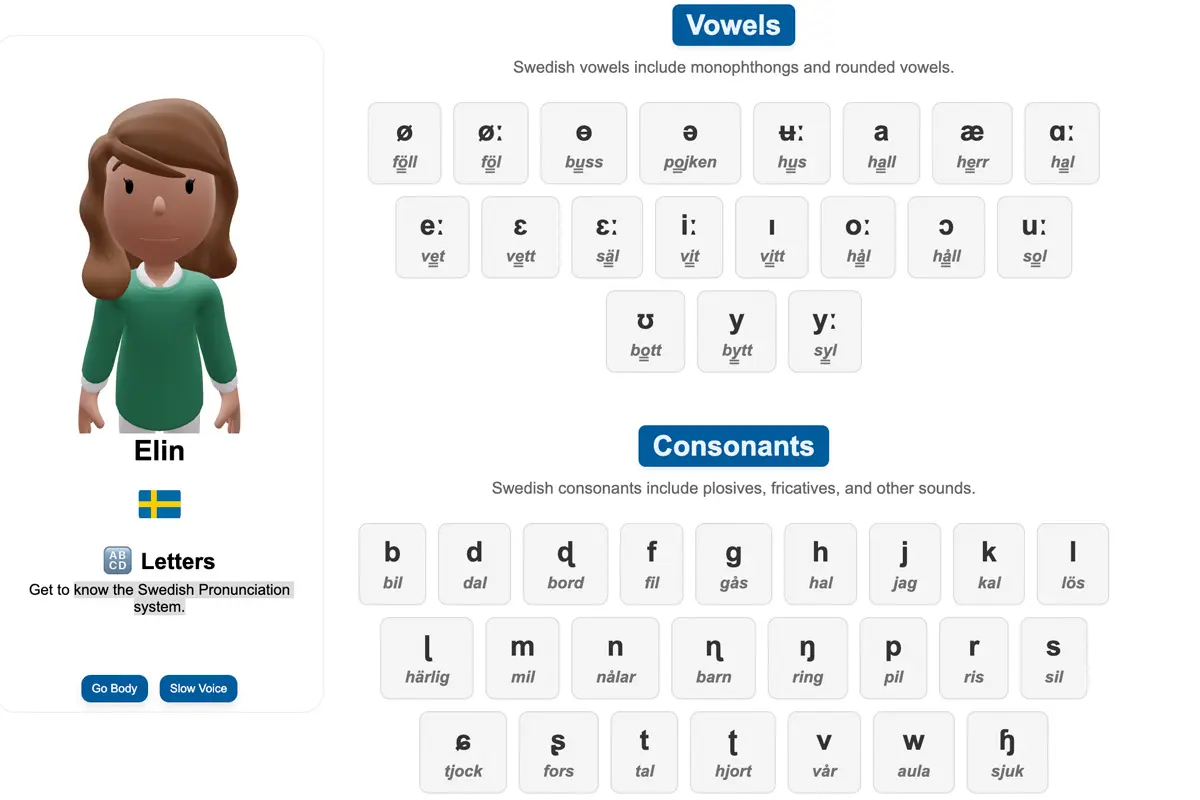
TL;DR
If you need how to learn Swedish language fast, focus on daily input + daily output: 60–90 minutes of comprehensible listening/reading and 20–30 minutes of speaking + writing. Use a 30-day sprint with spaced repetition, master pronunciation early (especially å/ä/ö and pitch accent), and live in Swedish via TV shows, podcasts, and short 1-on-1 chats with native speakers. Track micro-goals (word families, phrase banks, mini-dialogs), not abstract “hours studied.”
Introduction: What “Fast” Really Means
The question how to learn Swedish language fast usually hides two goals:
1 Reach A2/B1 conversational basics for work, studies, or travel.
2 Feel comfortable: ordering, small talk, basic emails, and navigating Swedish systems.
Fast ≠ frantic. You’ll move quicker by designing constraints—a fixed daily routine, a small core of high-frequency words, and repetitive interaction with Swedish as it’s really used. This guide gives you a pragmatic, research-informed plan that you can run for 30 days and repeat as needed.
Pro tip: Pair this guide with habit systems you already use. To reinforce the science behind pace and retention, see our practical primer on the spacing effect and memory schedules in this article which shows how intervals cement recall without burnout.
What Makes Swedish Learnable—Fast
Swedish is a North Germanic language closely related to Norwegian and Danish. For English speakers, vocabulary and structure often feel familiar. That’s a big win compared to languages with different scripts or tones. Three features to lean on:
- Transparent vocabulary: Many cognates (problem, telefon, universitet).
- Consistent verbs: No massive maze of irregular forms compared with, say, French.
- Word order: V2 main-clause order is learnable with patterns and lots of examples.
If you’ve learned or are learning other languages (even outside the Germanic family), the meta-skills of learning a new language—goal setting, exposure design, and active recall—transfer straight into Swedish.
Sound System & Spelling: Win Early, Win Fast
The “Fast Track” Sounds
Master these in Week 1:
- Å å (like aw in law): båt “boat”
- Ä ä (like a in cat but longer/cleaner): här “here”
- Ö ö (rounded mid-front vowel, like French eu): söt “sweet”
- Long vs. short vowels & consonants: vit vs. vitt
- Pitch accent (acute vs. grave patterns): learn with minimal pairs via slow, clear recordings
Why so early? Because phonology governs speed. If you hear accurately, you can read faster, SRS faster, and speak with fewer fossilized errors—your future self will thank you.
Mini-drill (5 minutes/day):
- Use Avatalks’ interactive toolto know the Swedish Pronunciation system.
- Shadow 5 high-frequency sentences (slow → natural speed).
- Record yourself, compare wave shapes and timing.
- Re-shadow focusing on vowel length and stress.

The 80/20 Lexicon: What to Learn First
You don’t need 8,000 words to chat. You need high-coverage chunks:
- Function words: och (and), men (but), för (for), eftersom (because)
- Core verbs: vara (be), ha (have), göra (do), gå (go), komma (come), vilja (want), kunna (can)
- Phrase frames: Jag skulle vilja… (I’d like to…), Kan jag få…? (May I have…?)
Build a phrase bank, not just a word list. Store them as ready-to-say sentences that fit real life: intros, ordering, directions, scheduling, greetings.
Need a broader study blueprint? Our overview of general tactics in Language Learning Tips: Fast and Effective Strategies lays out a simple system that plugs right into Swedish.
A 30-Day “Swedish Sprint” (Core Plan)
You’ll train Input, Output, and Systems every day. Keep it lean:
Daily Blocks (90–120 minutes total)
- Input (45–60 min): graded readers + podcasts + subtitled clips
- Output (20–30 min): voice notes to a tutor/partner; short written reflections
- Systems (10–20 min): spaced-repetition review; tiny grammar check-ups
Weekly Rhythm
- Mon–Thu: new content + micro-speaking
- Fri: review & consolidation
- Sat: conversation day (longer 1:1 or language exchange)
- Sun: fun immersion (TV shows, music, low-stress reading)
Template checklist (copy into your tracker):
- 10 new phrase-bank items
- 1 short conversation (5–10 min) with a native speaker
- 15 SRS reviews (+ new cards added)
- 15 minutes of pronunciation drills (å/ä/ö + length)
- 1 micro-writing (50–120 words): diary, recap, or questions
For habit scaffolding and day-to-day grammar touch-ups, these Quick Grammar Fixes can help you maintain momentum: see our practical guide to tiny edits and patterns in Daily Grammar Practice.
Input Design: Comprehensible, Interesting, Repeated
To learn Swedish fast, curate CI (comprehensible input). The formula:
- Start at i–1: slightly below your ceiling so you read/listen fluently.
- Loop content: watch/read twice—first for gist, second for details.
- Mine phrases: lift 2–5 expressions per session into your SRS.
Good sources to rotate:
- TV shows & clips with Swedish subtitles: short scenes, slice-of-life, news explainer segments.
- Podcasts at slow speed or with clear hosts; grab transcripts where possible.
- Easy readers or graded articles with audio.
One-hour CI sample:
- 20 min: subtitled clip → note 3 phrases
- 20 min: slow podcast segment → note 2 phrases
- 20 min: easy-reader chapter → note 3 phrases
- Total new phrases = 8 (perfect for SRS tonight)
Output Design: Say a Lot, Say It Simply
Output accelerates accuracy when it’s narrow, frequent, and corrective.
- Microscripts: Write and rehearse 5–8 sentences you’ll use this week (introductions, ordering coffee, booking, small talk).
- Voice notes to a tutor: 90 seconds, one topic. Ask for 2–3 corrections, not 20.
- Live 5-minute chat: schedule it; don’t “hope it happens.”
Even 5 minutes with a native speaker beats 0 minutes of “silent perfectionism.”
SRS Without the Grind
Spaced repetition cements recall, but it’s easy to overdo. Keep it lightweight:
- Add only phrases you actually want to say.
- Cap new to 10/day.
- Toss dead weight: if a card annoys you, delete or re-write it.
- Interleave pronunciation cards (minimal pairs, length contrasts).
To see why spacing matters (and how to time reviews), skim our spa-day for memory: The Spacing Effect, Explained Simply.
Grammar: Patterns Over Rules
You don’t need a thick grammar tome to move fast. Prioritize patterns:
- V2 word order in main clauses: the verb is the second element.
- Verb basics: present (Jag bor), past (Jag bodde), supine (har bott).
- Noun gender (en/ett) + definite forms (en bok → boken).
- Adjective agreement (en/ett/plural + definite): en röd bok, ett rött hus, röda böcker.
Micro-drill: Take one sentence and remix it five ways (question, negation, time-fronted, adjective change, definite/indefinite).
Pronunciation: The 10-Minute Daily Protocol
- Warm-up vowels: å/ä/ö with sustained tones (5 × 4 seconds).
- Minimal pairs for long/short vowels: vit/vitt, tal/tall, ful/full.
- Shadow 4 lines of a dialog (slow → natural speed).
- Record and compare stress pattern; adjust pitch accent by mimicry.
Why this matters: native-like rhythm makes your Swedish more intelligible even with limited vocabulary—and boosts your speaking skills confidence.
TV Shows & Music: Entertainment That Actually Teaches
You’ll retain more when it’s fun. Invest 20–30 minutes in TV shows with subtitles you can follow. Loop the same scene tomorrow and mine fresh phrases. Music with clear lyrics also works—stick to slow songs at first.
Workflow:
- First pass: watch for story only.
- Second pass: pause to echo lines.
- Phrase mining: grab 2–3 that you genuinely like.
The 5-Conversation Challenge (Week 2–4)
Schedule five short calls (5–10 minutes) with a tutor or exchange partner:
- Conversation #1: Introductions, where you live/study/work.
- #2: Daily routine, hobbies, why you’re learning Swedish.
- #3: Ordering food, buying tickets, basic travel phrases.
- #4: Plans and scheduling, future tense patterns (ska, kommer att).
- #5: Review earlier topics at faster speed.
Keep notes on 5–10 new items per chat. Those become your next day’s SRS.
30-Day Milestones (What “Fast” Progress Looks Like)
| Day | Milestone | Evidence You’ll See |
|---|---|---|
| 7 | Sound & spelling basics | You can hear/produce å/ä/ö contrasts; simpler shadowing feels natural |
| 14 | Scripted dialogs | 2–3 microscripts roll off your tongue (ordering, greetings) |
| 21 | Small talk | You can hold 5-minute chats with slow speech and repetition |
| 30 | Functional A2 | You can navigate common tasks; reading simple posts without constant lookup |
Document wins daily. Motivation compounds when you can see progress.
Motivation & Consistency: Make “Fast” Sustainable
- Make it visible: streak tracker for input, output, SRS.
- Tiny wins: 10 minutes counts. Don’t break the chain.
- Rotate modalities: when reading bores you, listen; when listening stalls, speak.
- Community: a weekly check-in with a partner keeps the sprint honest.
For a broader system of small, durable improvements, grab ideas from our fast-acting study tweaks here: Language Learning Tips.
Comparing With Other Languages (So You Don’t Overthink “Hard”)
If you’ve dabbled in German, you’ll notice overlap that speeds you up (cognates, similar syntax in places). If you’ve studied a very different language (say, Japanese or Arabic), Swedish will feel mercifully familiar—no new script, no tones, fewer barriers between hearing and saying.
Side note for cross-learners of Turkish: Turkish’s agglutinative grammar and vowel harmony are very different; many native Turkish speakers who learn Swedish rely on immersion and conversation to bridge the structural gap. (We discuss this mindset in our Turkey-focused posts.)
Troubleshooting: Why Your “Fast” Stalls (and Fixes)
Symptom: You “understand nothing” when listening.
Fix: Drop level; loop shorter segments; shadow slowly. Aim for 95%+ comprehension.
Symptom: You forget yesterday’s words.
Fix: Add fewer, use them today in a voice note; review with SRS tomorrow.
Symptom: You freeze in conversation.
Fix: Script 6 lines on today’s topic; read them once; then speak from memory.
Symptom: Boredom.
Fix: Switch inputs (news → sitcom clip); revive interest via TV shows you truly enjoy.
Sample 7-Day Micro-Plan (Copy/Paste)
Day 1: Sounds (å/ä/ö), 8 phrases from an easy article; 90-sec voice note: intro.
Day 2: Vowel length, 8 phrases from a slow podcast; voice note: hobbies.
Day 3: V2 patterns with time adverbs; mini-dialog: café ordering.
Day 4: Article + clip; 5-minute call (greetings + orders).
Day 5: Consolidate; SRS only 8 cards; fun music session.
Day 6: Pitch accent tune-up; 8 fresh phrases; voice note: weekend plans.
Day 7: Review everything; longer call (7–10 min); celebrate.
FAQ: How to Learn Swedish Language Fast
Is 30 days enough to speak?
You can reach functional basics (A2-ish) with consistent daily input/output and 5 short conversations.
How many words do I need?
A phrase bank of 200–400 high-frequency chunks gets you moving faster than a raw “1,000-word” target.
Should I study grammar first?
No. Learn patterns inside phrases, then peek at rules to clarify.
Do I need a tutor right away?
A weekly 10-minute chat from Week 1 de-dramatizes speaking and speeds corrections.
10 Quick Wins (Checklist)
- Master å/ä/ö + vowel length
- Learn 7 core verbs and 5 phrase frames
- Watch one looped clip (2×) daily
- Add only useful phrases to SRS (≤10 new/day)
- Shadow 4 lines/day
- Schedule five 5–10-minute calls this month
- Track streaks (input/output/SRS)
- Rotate fun media (TV shows, music)
- Write 80–120 words every other day
- Celebrate tiny milestones (first order, first small talk)
Conclusion
“Fast” Swedish isn’t a hack; it’s a tight feedback loop—listen, read, speak, fix, repeat. Keep your lane narrow (core phrases, clear sounds, short daily sessions), and you’ll be surprised how quickly Swedish becomes usable. Start today: pick your first clip, mine eight phrases, and send a 90-second voice note. That’s the first brick. Lay one every day.
References
- Study in Sweden — official advice on learning Swedish and course options (universities, online resources).
https://studyinsweden.se/moving-to-sweden/learn-swedish/ - University of Gothenburg — Språkbanken (dictionaries & corpora useful for learners).
https://spraakbanken.gu.se/ - Tyda — EN↔SV dictionary with audio.
https://tyda.se/ - Avatalks 3D interactive table — Learn Swedish pronunciation and alphabet. https://avatalks.com/tools/character/character-character-sv?studyingLanguage=sv
- EF EPI — English proficiency context for Swedish society (why you can get by early while you ramp up Swedish).
https://www.ef.com/wwen/epi/